Sensitivity and Performance Analyses of the Distributed Hydrology–Soil–Vegetation Model Using Geomorphons for Landform Mapping
Abstract
:1. Introduction
2. Materials and Methods
2.1. Study Area
2.2. Data
2.3. Geomorphons
2.4. Distributed Hydrology Soil Vegetation Model (DHSVM)
2.5. DHSVM Input Data
2.6. DHSVM Calibration and Validation
2.7. DHSVM Sensitivity Analysis
3. Results and Discussion
3.1. Surface Map Geomorphons
3.2. Sensitivity Analysis
3.3. DHSVM Calibration and Validation Using Geomorphons
3.4. Soil Moisture Spatial Distribution
4. Conclusions
Author Contributions
Funding
Institutional Review Board Statement
Informed Consent Statement
Data Availability Statement
Acknowledgments
Conflicts of Interest
References
- Chu, H.J.; Lin, Y.P.; Huang, C.W.; Hsu, C.Y.; Chen, H.Y. Modelling the Hydrologic Effects of Dynamic Land–Use Change Using a Distributed Hydrologic Model and a Spatial Land–Use Allocation Model. Hydrol. Process. 2010, 24, 2538–2554. [Google Scholar] [CrossRef]
- Alvarenga, L.A.; Mello, C.R.; Colombo, A.; Chou, S.C.; Cuartas, L.A.; Viola, M.R. Impacts of Climate Change on the Hydrology of a Small Brazilian Headwater Catchment Using the Distributed Hydrology–Soil–Vegetation Model. Am. J. Clim. Chang. 2018, 7, 355–366. [Google Scholar] [CrossRef] [Green Version]
- Safeeq, M.; Fares, A. Hydrologic Response of a Hawaiian Watershed to Future Climate Change Scenarios. Hydrol. Process. 2012, 26, 2745–2764. [Google Scholar] [CrossRef]
- Alvarenga, L.A.; de Mello, C.R.; Colombo, A.; Cuartas, L.A.; Bowling, L.C. Assessment of Land Cover Change on the Hydrology of a Brazilian Headwater Watershed Using the Distributed Hydrology–Soil–Vegetation Model. Catena 2016, 143, 7–17. [Google Scholar] [CrossRef]
- Dee, D.P.; Uppala, S.M.; Simmons, A.J.; Berrisford, P.; Poli, P.; Kobayashi, S.; Andrae, U.; Balmaseda, M.A.; Balsamo, G.; Bauer, P.; et al. The ERA–Interim Reanalysis: Configuration and Performance of the Data Assimilation System. Q. J. R. Meteorol. Soc. 2011, 137, 553–597. [Google Scholar] [CrossRef]
- Horan, R.; Gowri, R.; Wable, P.S.; Baron, H.; Keller, V.D.J.; Garg, K.K.; Mujumdar, P.P.; Houghton–Carr, H.; Rees, G. A Comparative Assessment of Hydrological Models in the Upper Cauvery Catchment. Water 2021, 13, 151. [Google Scholar] [CrossRef]
- Wigmosta, M.S.; Vail, L.W.; Lettenmaier, D.P. A Distributed Hydrology–vegetation Model for Complex Terrain. Water Resour. Res. 1994, 30, 1665–1679. [Google Scholar] [CrossRef]
- Cuartas, L.A.; Tomasella, J.; Nobre, A.D.; Nobre, C.A.; Hodnett, M.G.; Waterloo, M.J.; de Oliveira, S.M.; von Randow, R.d.C.; Trancoso, R.; Ferreira, M. Distributed Hydrological Modeling of a Micro–Scale Rainforest Watershed in Amazonia: Model Evaluation and Advances in Calibration Using the New HAND Terrain Model. J. Hydrol. 2012, 462–463, 15–27. [Google Scholar] [CrossRef]
- Srivastava, A.; Deb, P.; Kumari, N. Multi–Model Approach to Assess the Dynamics of Hydrologic Components in a Tropical Ecosystem. Water Resour. Manag. 2020, 34, 327–341. [Google Scholar] [CrossRef]
- Darbandsari, P.; Coulibaly, P. Inter–Comparison of Lumped Hydrological Models in Data–Scarce Watersheds Using Different Precipitation Forcing Data Sets: Case Study of Northern Ontario, Canada. J. Hydrol. Reg. Stud. 2020, 31, 100730. [Google Scholar] [CrossRef]
- Moustakas, S.; Willems, P. Testing the Efficiency of Parameter Disaggregation for Distributed Rainfall–Runoff Modelling. Water 2021, 13, 972. [Google Scholar] [CrossRef]
- Seibert, J.; Staudinger, M.; van Meerveld, H.J. (Ilja) Validation and Over–Parameterization—Experiences from Hydrological Modeling. In Computer Simulation Validation: Fundamental Concepts, Methodological Frameworks, and Philosophical Perspectives; Beisbart, C., Saam, N.J., Eds.; Simulation Foundations, Methods and Applications; Springer International Publishing: Cham, Switzerland, 2019; pp. 811–834. ISBN 978–3–319–70766–2. [Google Scholar]
- Beven, K. Prophecy, Reality and Uncertainty in Distributed Hydrological Modelling. Adv. Water Resour. 1993, 16, 41–51. [Google Scholar] [CrossRef]
- Antonetti, M.; Scherrer, S.; Kienzler, P.M.; Margreth, M.; Zappa, M. Process–Based Hydrological Modelling: The Potential of a Bottom–up Approach for Runoff Predictions in Ungauged Catchments. Hydrol. Process. 2017, 31, 2902–2920. [Google Scholar] [CrossRef]
- Savenije, H.H.G. HESS Opinions “Topography Driven Conceptual Modelling (FLEX–Topo)”. Hydrol. Earth Syst. Sci. 2010, 14, 2681–2692. [Google Scholar] [CrossRef] [Green Version]
- Alvarenga, L.A.; de Mello, C.R.; Colombo, A.; Cuartas, L.A. Performance of a Distributed Hydrological Model Based on Soil and Moisture Zone Maps. Rev. Bras. De Cienc. Do Solo 2017, 41. [Google Scholar] [CrossRef] [Green Version]
- Iwahashi, J.; Pike, R.J. Automated Classifications of Topography from DEMs by an Unsupervised Nested–Means Algorithm and a Three–Part Geometric Signature. Geomorphology 2007, 86, 409–440. [Google Scholar] [CrossRef]
- Rennó, C.D.; Nobre, A.D.; Cuartas, L.A.; Soares, J.V.; Hodnett, M.G.; Tomasella, J.; Waterloo, M.J. HAND, a New Terrain Descriptor Using SRTM–DEM: Mapping Terra–Firme Rainforest Environments in Amazonia. Remote Sens. Environ. 2008, 112, 3469–3481. [Google Scholar] [CrossRef]
- Jasiewicz, J.; Stepinski, T.F. Geomorphons—A Pattern Recognition Approach to Classification and Mapping of Landforms. Geomorphology 2013, 182, 147–156. [Google Scholar] [CrossRef]
- Pinheiro, H.S.K.; Owens, P.R.; Chagas, C.S.; Carvalho Júnior, W.; Anjos, L.H.C. Applying Artificial Neural Networks Utilizing Geomorphons to Predict Soil Classes in a Brazilian Watershed. In Igital Soil Mapping Across Paradigms, Scales and Boundaries; Springer: Singapore, 2016. [Google Scholar]
- Silva, S.H.G.; de Menezes, M.D.; de Mello, C.R.; de Góes, H.T.P.; Owens, P.R.; Curi, N. Geomorphometric Tool Associated with Soil Types and Properties Spatial Variability at Watersheds under Tropical Conditions. Sci. Agric. 2016, 73, 363–370. [Google Scholar] [CrossRef] [Green Version]
- Pinto, L.C.; Mello, C.R.; Norton, L.D.; Owens, P.R.; Curi, N. Spatial Prediction of Soil–Water Transmissivity Based on Fuzzy Logic in a Brazilian Headwater Watershed. Catena 2016, 143, 26–34. [Google Scholar] [CrossRef]
- Pinto, L.C.; de Mello, C.R.; Norton, L.D.; Silva, S.H.G.; Taveira, L.R.S.; Curi, N. Land–Use Effect on Hydropedology in a Mountainous Region of Southeastern Brazil. Ciência E Agrotecnologia 2017, 41, 413–427. [Google Scholar] [CrossRef] [Green Version]
- Viola, M.R.; Mello, C.R.; Beskow, S.; Norton, L.D. Impacts of Land–Use Changes on the Hydrology of the Grande River Basin Headwaters, Southeastern Brazil. Water Resour. Manag. 2014, 28, 4537–4550. [Google Scholar] [CrossRef]
- Junqueira Júnior, J.A.; da Silva, A.M.; de Mello, C.R.; Pinto, D.B.F. Continuidade Espacial de Atributos Físico–Hídricos Do Solo Em Sub–Bacia Hidrográfica de Cabeceira. Cienc. E Agrotecnologia 2008, 32, 914–922. [Google Scholar] [CrossRef] [Green Version]
- Menezes, M.D.; Junqueira, J.A.; De Mello, C.R.; Da Silva, A.M.; Curi, N.; Marques, J.J. Dinâmica Hidrológica de Duas Nascentes, Associada Ao Uso Do Solo, Características Pedológicas e Atributos Físico—Hídricos Na Sub–Bacia Hidrográfica Do Ribeirão Lavrinha—Serra Da Mantiqueira (MG). Sci. For. For. Sci. 2009, 37, 175–184. [Google Scholar]
- de Castro Nunes Santos Terra, M.; de Mello, J.M.; de Mello, C.R.; dos Santos, R.M.; Nunes, A.C.R.; Raimundo, M.R. Influência Topo–Edafo–Climática Na Vegetação de Um Fragmento de Mata Atlântica Na Serra Da Mantiqueira, MG. Rev. Ambiente E Agua 2015, 10, 928–942. [Google Scholar] [CrossRef] [Green Version]
- Mello, C.R.; Ávila, L.F.; Lin, H.; Terra, M.C.N.S.; Chappell, N.A. Water Balance in a Neotropical Forest Catchment of Southeastern Brazil. Catena 2019, 173, 9–21. [Google Scholar] [CrossRef] [Green Version]
- Gao, H.; Hrachowitz, M.; Fenicia, F.; Gharari, S.; Savenije, H.H.G. Testing the Realism of a Topography–Driven Model (FLEX–Topo) in the Nested Catchments of the Upper Heihe, China. Hydrol. Earth Syst. Sci. 2014, 18, 1895–1915. [Google Scholar] [CrossRef] [Green Version]
- ANA. SPR O Plano Integrado de Recursos Hídricos Da Bacia Hidrográfica Do Rio Grande; Agência Nacional de Água: Brasilia, Brasil, 2017; p. 310.
- Yokoyama, R.; Shirasawa, M.; Pike, R.J. Visualizing Topography by Openness: A New Application of Image Processing to Digital Elevation Models. Photogramm. Eng. Remote Sens. 2002, 68, 257–266. [Google Scholar]
- Thanapakpawin, P.; Richey, J.; Thomas, D.; Rodda, S.; Campbell, B.; Logsdon, M. Effects of Landuse Change on the Hydrologic Regime of the Mae Chaem River Basin, NW Thailand. J. Hydrol. 2007, 334, 215–230. [Google Scholar] [CrossRef]
- Wigmosta, M.S.; Nijssen, B.; Storck, P. The distributed hydrology soil vegetation model. In Mathematical Models of Small Watershed Hydrology and Applications; Water Resources Publications: Chelsea, Michigan, 2002; pp. 7–42. ISBN 1–887201–35–1. [Google Scholar]
- Bras, R.L. Hydrology: An Introduction to Hydrologic Science; Addison Wesley Publishing Company: Boston, MA, USA, 1990. [Google Scholar]
- Swinbank, W.C. Long–wave Radiation from Clear Skies. Q. J. R. Meteorol. Soc. 1963, 89, 339–348. [Google Scholar] [CrossRef]
- de Mendes, H.A.; Cecílio, R.A.; Zanetti, S.S. Influence of Soil Depth and Spatial Resolution on the Performance of the DHSVM Hydrological Model in Basins with Low Input Data Availability. J. South. Am. Earth Sci. 2020, 105, 102993. [Google Scholar] [CrossRef]
- Oliveira, A.S.; Silva, A.M.; Mello, C.R.; Alves, G.J. Stream Flow Regime of Springs in the Mantiqueira Mountain Range Region, Minas Gerais State. CERNE 2014, 20, 343–349. [Google Scholar] [CrossRef] [Green Version]
- Du, E.; Link, T.E.; Gravelle, J.A.; Hubbart, J.A. Validation and Sensitivity Test of the Distributed Hydrology Soil–Vegetation Model (DHSVM) in a Forested Mountain Watershed. Hydrol. Process. 2014, 28, 6196–6210. [Google Scholar] [CrossRef]
- Moriasi, D.N.; Gitau, M.W.; Pai, N.; Daggupati, P. Hydrologic and Water Quality Models: Performance Measures and Evaluation Criteria. Trans. ASABE 2015, 58, 1763–1785. [Google Scholar] [CrossRef] [Green Version]
- Kruk, N.; Chou, S.C.; Ladeira, F.; Vendrame, I. Análise de Sensibilidade Do Modelo Hidrológico Distribuído DHSVM Aos Parâmetros de Vegetação. Rev. Bras. De Recur. Hídricos 2009, 14, 75–84. [Google Scholar] [CrossRef]
- Tegegne, G.; Park, D.K.; Kim, Y.O. Comparison of Hydrological Models for the Assessment of Water Resources in a Data–Scarce Region, the Upper Blue Nile River Basin. J. Hydrol. Reg. Stud. 2017, 14, 49–66. [Google Scholar] [CrossRef]
- Conforti, M.; Longobucco, T.; Scarciglia, F.; Niceforo, G.; Matteucci, G.; Buttafuoco, G. Interplay between Soil Formation and Geomorphic Processes along a Soil Catena in a Mediterranean Mountain Landscape: An Integrated Pedological and Geophysical Approach. Environ. Earth Sci. 2020, 79, 1–16. [Google Scholar] [CrossRef]
- Reli, S.N.; Yusoff, I.M.; Lateh, H.; Ujang, M.U. A Review of Infiltration Excess Overland Flow (IEOF): Terms, Models and Environmental Impact. J. Adv. Humanit. 2016, 4, 490–502. [Google Scholar] [CrossRef]
- Gao, H.; Sabo, J.L.; Chen, X.; Liu, Z.; Yang, Z.; Ren, Z.; Liu, M. Landscape Heterogeneity and Hydrological Processes: A Review of Landscape–Based Hydrological Models. Landsc. Ecol. 2018, 33, 1461–1480. [Google Scholar] [CrossRef]
- Beckers, J.; Alila, Y. A Model of Rapid Preferential Hillslope Runoff Contributions to Peak Flow Generation in a Temperate Rain Forest Watershed. Water Resour. Res. 2004, 40. [Google Scholar] [CrossRef] [Green Version]
- Yilmaz, K.K.; Gupta, H.V.; Wagener, T. A Process–Based Diagnostic Approach to Model Evaluation: Application to the NWS Distributed Hydrologic Model. Water Resour. Res. 2008, 44. [Google Scholar] [CrossRef] [Green Version]
- Ávila, L.F.; de Mello, C.R.; da Silva, A.M. Continuidade e Distribuição Espacial Da Umidade Do Solo Em Bacia Hidrográfica Da Serra Da Mantiqueira. Rev. Bras. De Eng. Agrícola E Ambient. 2010, 14, 1257–1266. [Google Scholar] [CrossRef] [Green Version]
- Lazzari, M.; Piccarreta, M.; Manfreda, S. The Role of Antecedent Soil Moisture Conditions on Rainfall–Triggered Shallow Landslides. Nat. Hazards Earth Syst. Sci. Discuss. 2018, 1–11. [Google Scholar] [CrossRef] [Green Version]
- Lazzari, M.; Piccarreta, M.; Ray, R.L.; Manfreda, S. Modeling Antecedent Soil Moisture to Constrain Rainfall Thresholds for Shallow Landslides Occurrence. In Landslides—Investigation and Monitoring; IntechOpen: London, UK, 2020; ISBN 978–1–78985–824–2. [Google Scholar]

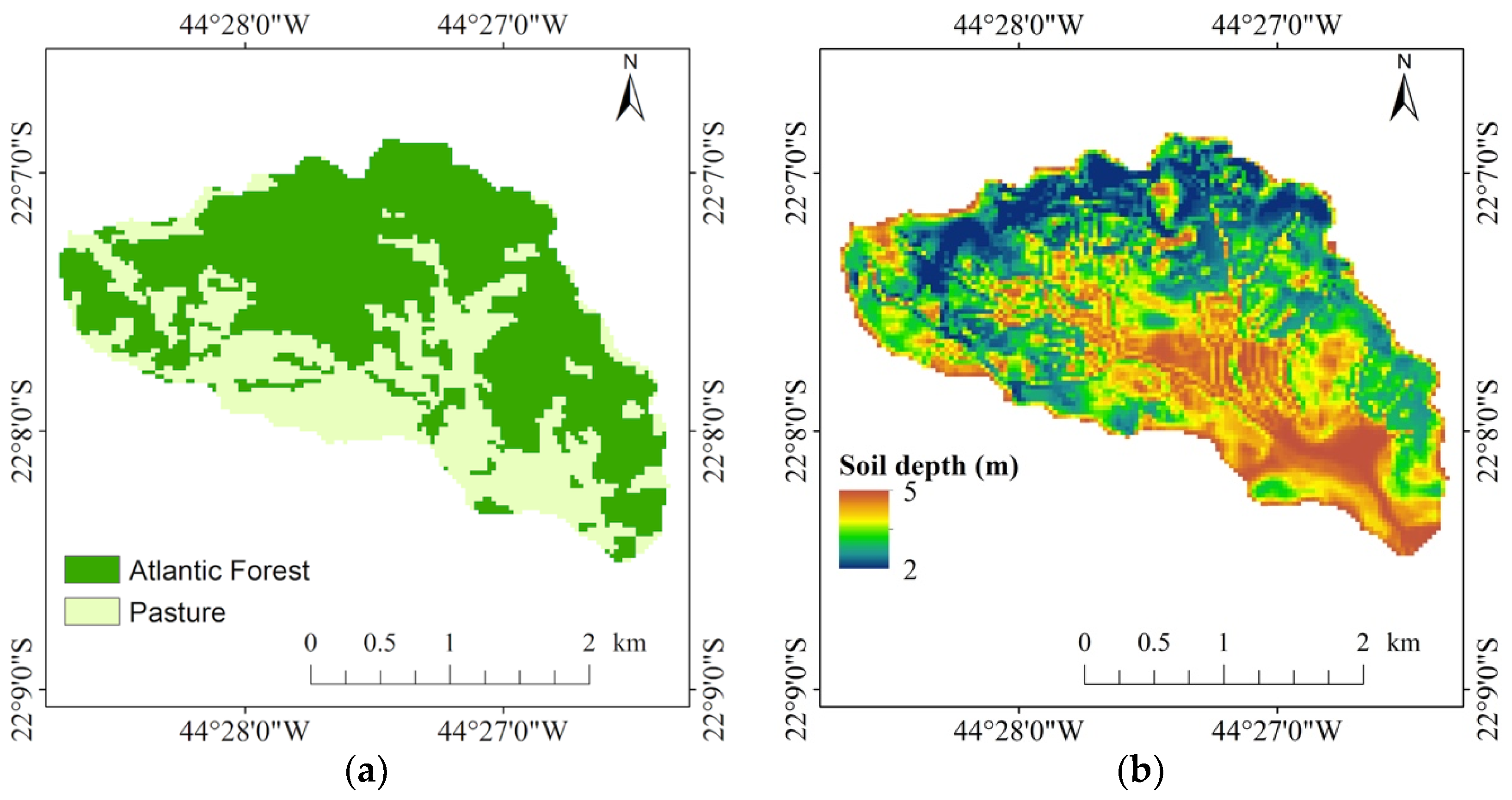
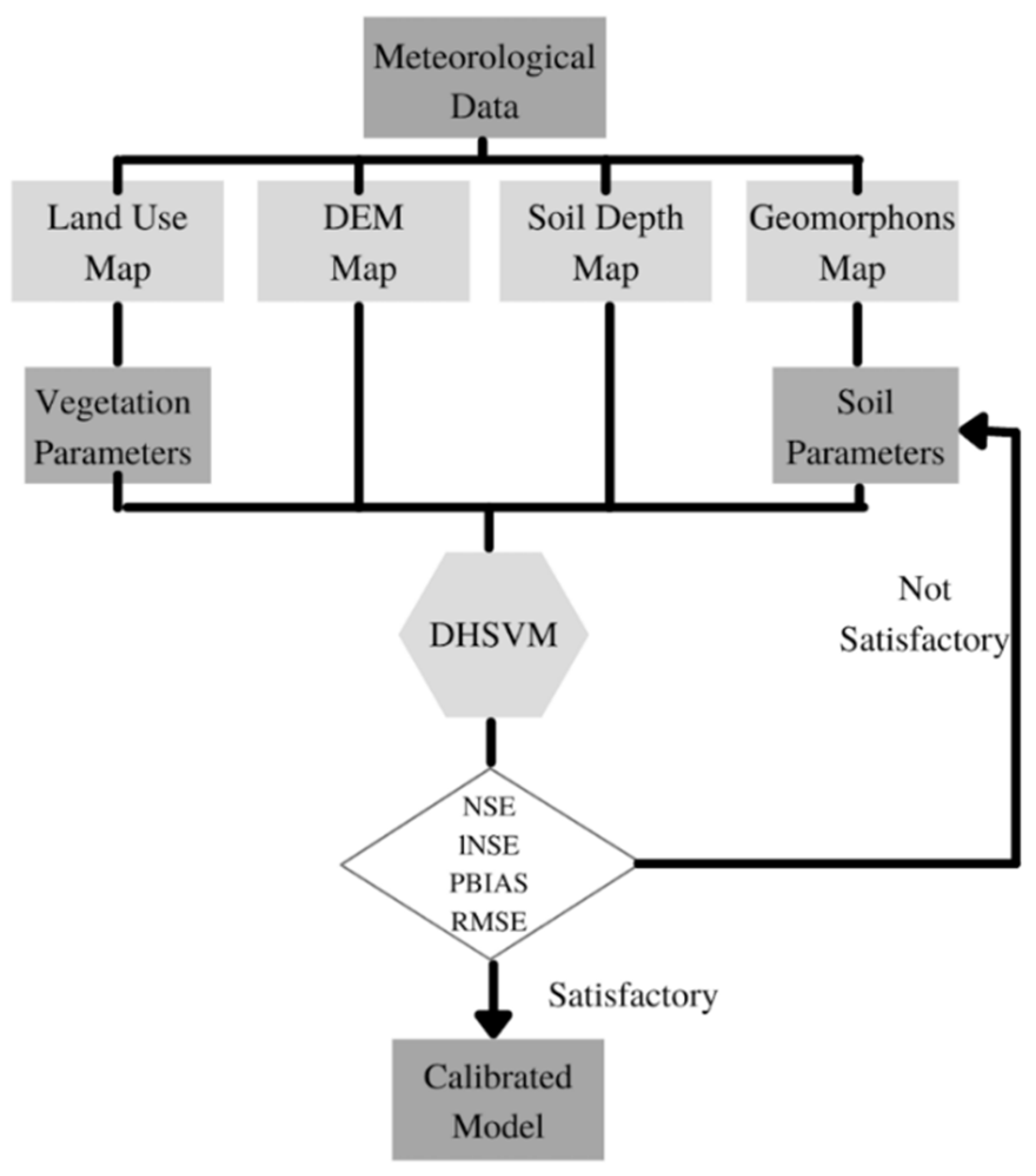
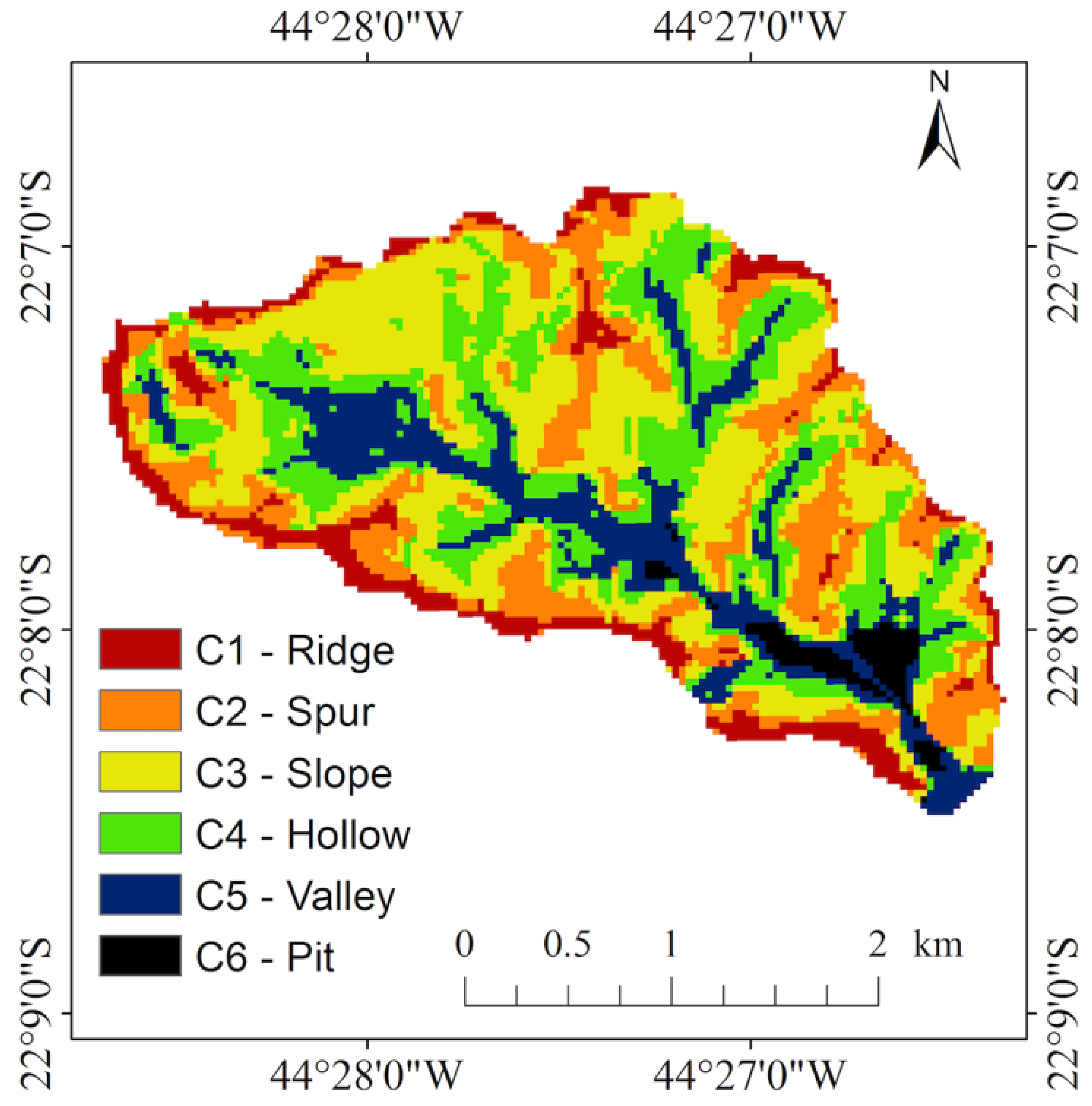


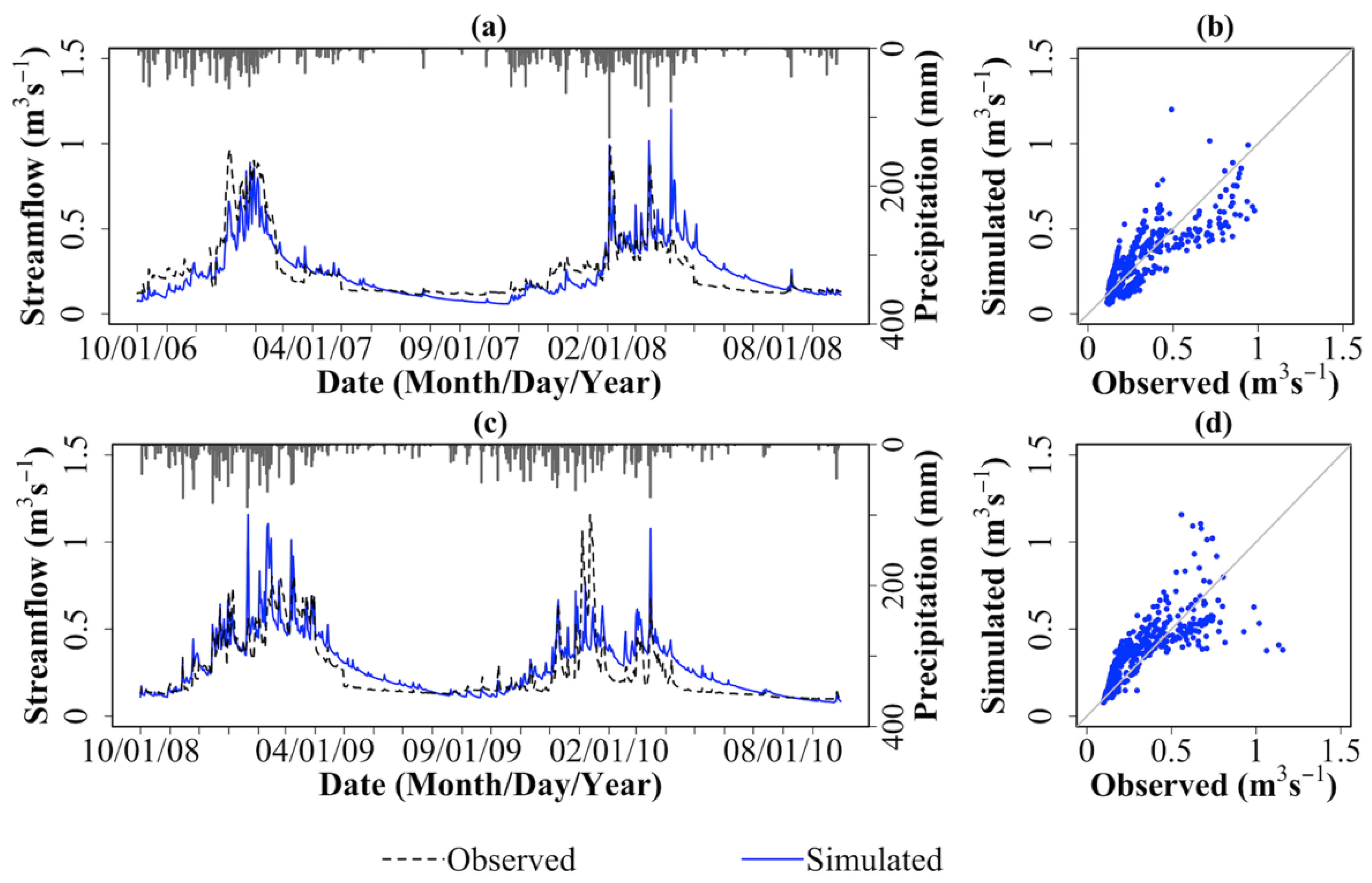
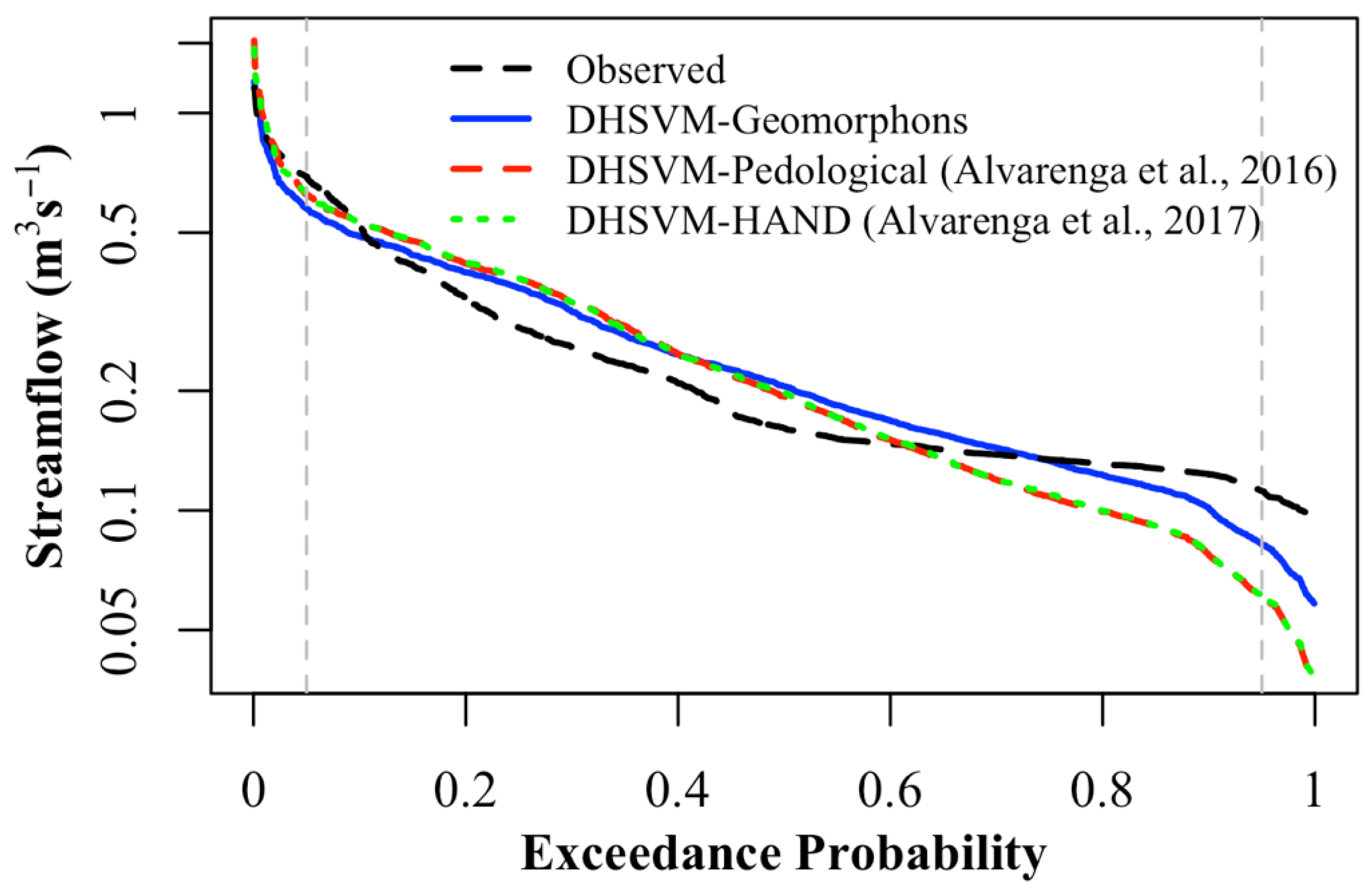
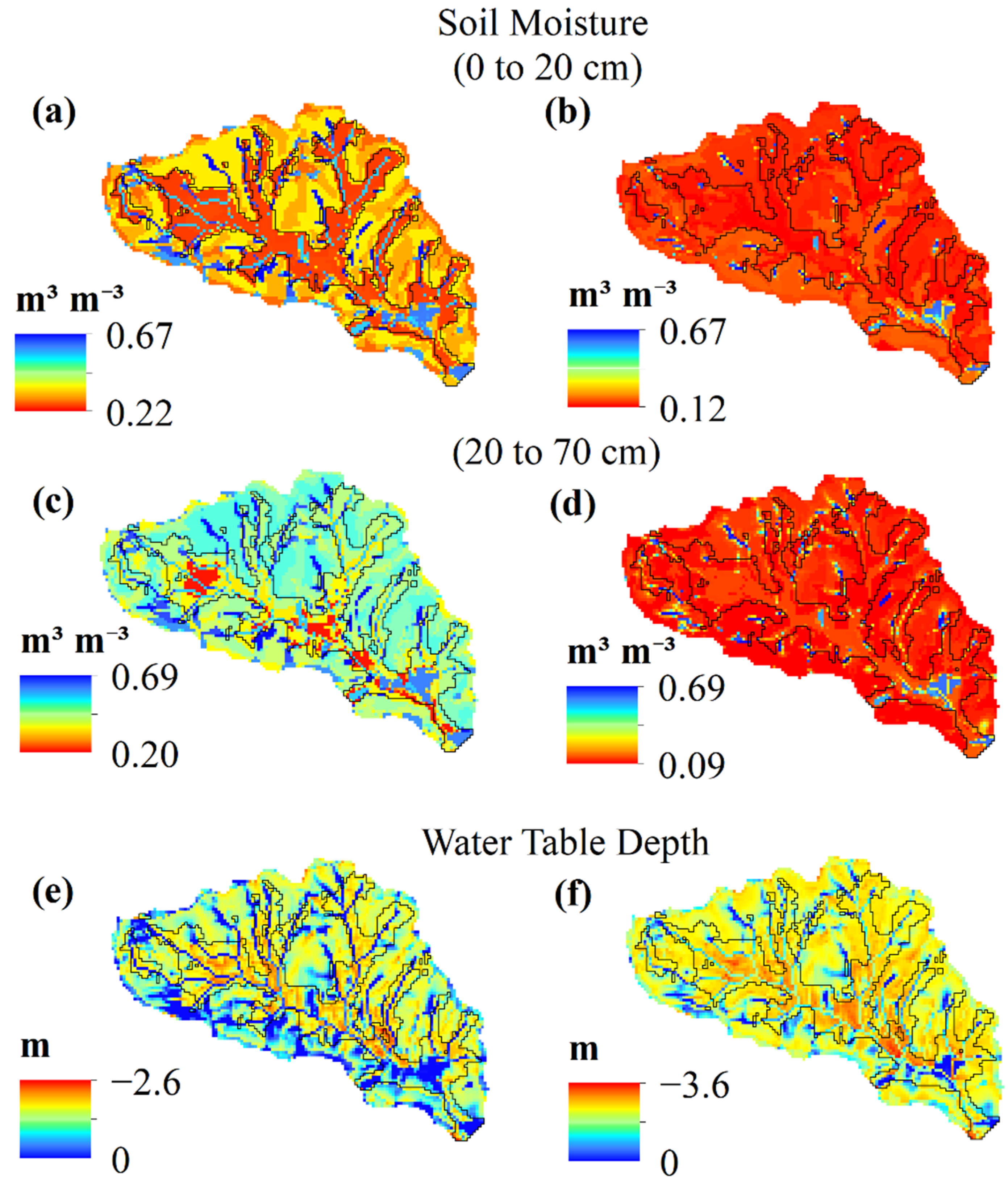
| Parameters | Atlantic Forest | Pasture | |
|---|---|---|---|
| Overstory | Understory | ||
| Fractional coverage | 0.95 | - | - |
| Trunk space | 0.50 | - | - |
| Aerodynamic attenuation | 2.50 | - | - |
| Radiation attenuation coefficient | 0.71 | - | - |
| Height (m) | 20.00 | 1.00 | 0.60 |
| Maximum stomatal resistance (s m−1) | 3600.00 | 2787.50 | 5000.00 |
| Minimum stomatal resistance (s m−1) | 185.70 | 185.70 | 120.00 |
| Soil moisture threshold (cm3 cm−3) | 0.10 | 0.10 | 0.14 |
| Vapor deficit pressure (Pa) | 4000 | 4000 | 4202 |
| Fraction of photosynthetically active shortwave radiation (W m −2) | 0.43 | 0.17 | 0.43 |
| Number of root zones (equal to soil layers) | 3 | 3 | 3 |
| Root zone depths (equal to thickness soil in m) | 0.20 | 0.20 | |
| 0.70 | 0.30 | ||
| 0.90 | 0.30 | ||
| Root fraction for layer (%) | 0.40 | 0.40 | 0.50 |
| 0.40 | 0.60 | 0.50 | |
| 0.20 | 0.00 | 0.00 | |
| Monthly leaf area index (m2 m−2) | 5.00 | 1.70 | 2.90 |
| 4.64 | 1.58 | 2.40 | |
| 3.93 | 1.34 | 2.60 | |
| 3.90 | 1.33 | 1.70 | |
| 4.89 | 1.66 | 1.60 | |
| 2.66 | 0.90 | 1.40 | |
| 4.15 | 1.41 | 1.55 | |
| 4.44 | 1.51 | 1.50 | |
| 4.81 | 1.63 | 2.20 | |
| 4.50 | 1.53 | 2.30 | |
| 3.81 | 1.30 | 2.18 | |
| 5.00 | 1.70 | 3.00 | |
| Monthly albedo | 0.12 | 0.12 | 0.20 |
| Parameter | Reference Value | Perturbation (Multipliers) | Literature References | ||
|---|---|---|---|---|---|
| Haplic Cambisol | Haplic Gleysol | Fluvisol | |||
| ED | 1 | 1 | 1 | 0.01, 0.1, 0.5, 0.7, 1.3, 2, 10, 100 | [8] |
| LSHC (10−4 m s−1) | 0.19 | 0.33 | 0.28 | 0.7, 0.8, 0.9, 0.95, 1.05, 1.1, 1.2, 1.3 | [25] |
| PR | 0.58 | 0.60 | 0.55 | 0.7, 0.8, 0.9, 0.95, 1.05, 1.1, 1.2, 1.3 | [25] |
| FC | 0.32 | 0.32 | 0.32 | 0.7, 0.8, 0.9, 0.95, 1.05, 1.1, 1.2, 1.3 | [25] |
| WP | 0.12 | 0.12 | 0.12 | 0.7, 0.8, 0.9, 0.95, 1.05, 1.1, 1.2, 1.3 | [25] |
| Parameter | Soil Features | |||||
|---|---|---|---|---|---|---|
| C1 | C2 | C3 | C4 | C5 | C6 | |
| Ridge | Spur | Slope | Hollow | Valley | Pit | |
| Area fraction (%) | 10 | 20 | 32 | 22 | 14 | 2 |
| Lateral conductivity—LSHC (10−4 m s−1) | 0.15 | 0.13 | 0.13 | 0.27 | 0.31 | 0.33 |
| Exponential decay of LSHC—ED | 0.7 | 0.1 | 0.1 | 0.01 | 0.001 | 0.001 |
| Porosity—PR | 0.58 * | 0.63 * | 0.67 * | 0.64 * | 0.55 * | 0.60 * |
| 0.60 ** | 0.65 ** | 0.69 ** | 0.66 ** | 0.57 ** | 0.62 ** | |
| 0.62 *** | 0.67 *** | 0.71 *** | 0.68 *** | 0.59 *** | 0.64 *** | |
| Field capacity—FC | 0.21 * | 0.21 * | 0.21 * | 0.21 * | 0.19 * | 0.29 * |
| 0.22 ** | 0.22 ** | 0.22 ** | 0.22 ** | 0.20 ** | 0.30 ** | |
| 0.24 *** | 0.24 *** | 0.24 *** | 0.24 *** | 0.21 *** | 0.32 *** | |
| Permanent wilting point— | 0.09 * | 0.09 * | 0.09 * | 0.09 * | 0.12 * | 0.14 * |
| WP | 0.09 ** | 0.09 ** | 0.09 ** | 0.09 ** | 0.12 ** | 0.14 ** |
| 0.09 *** | 0.09 *** | 0.09 *** | 0.09 *** | 0.12 *** | 0.14 *** | |
| Vertical conductivity— | 0.15 * | 0.13 * | 0.13 * | 0.27 * | 0.31 * | 0.33 * |
| VSHC (10−4 m s−1) | 0.14 ** | 0.12 ** | 0.12 ** | 0.26 ** | 0.305 ** | 0.32 ** |
| 0.13 *** | 0.11 *** | 0.11 *** | 0.25 *** | 0.30 *** | 0.31 *** | |
| Procedure | Interval | NSE | lNSE | PBIAS (%) | RMSE |
|---|---|---|---|---|---|
| Geomorphons | Calibration | 0.68 | 0.53 | −4 | 0.10 |
| Validation | 0.63 | 0.70 | 13 | 0.11 | |
| Pedological [4] | Calibration | 0.52 | 0.06 | −2 | 0.12 |
| Validation | 0.52 | 0.58 | 13 | 0.13 | |
| HAND [16] | Calibration | 0.57 | 0.10 | −2.1 | 0.12 |
| Validation | 0.55 | 0.60 | 13 | 0.12 |
Publisher’s Note: MDPI stays neutral with regard to jurisdictional claims in published maps and institutional affiliations. |
© 2021 by the authors. Licensee MDPI, Basel, Switzerland. This article is an open access article distributed under the terms and conditions of the Creative Commons Attribution (CC BY) license (https://creativecommons.org/licenses/by/4.0/).
Share and Cite
Melo, P.A.; Alvarenga, L.A.; Tomasella, J.; Mello, C.R.; Martins, M.A.; Coelho, G. Sensitivity and Performance Analyses of the Distributed Hydrology–Soil–Vegetation Model Using Geomorphons for Landform Mapping. Water 2021, 13, 2032. https://doi.org/10.3390/w13152032
Melo PA, Alvarenga LA, Tomasella J, Mello CR, Martins MA, Coelho G. Sensitivity and Performance Analyses of the Distributed Hydrology–Soil–Vegetation Model Using Geomorphons for Landform Mapping. Water. 2021; 13(15):2032. https://doi.org/10.3390/w13152032
Chicago/Turabian StyleMelo, Pâmela A., Lívia A. Alvarenga, Javier Tomasella, Carlos R. Mello, Minella A. Martins, and Gilberto Coelho. 2021. "Sensitivity and Performance Analyses of the Distributed Hydrology–Soil–Vegetation Model Using Geomorphons for Landform Mapping" Water 13, no. 15: 2032. https://doi.org/10.3390/w13152032
APA StyleMelo, P. A., Alvarenga, L. A., Tomasella, J., Mello, C. R., Martins, M. A., & Coelho, G. (2021). Sensitivity and Performance Analyses of the Distributed Hydrology–Soil–Vegetation Model Using Geomorphons for Landform Mapping. Water, 13(15), 2032. https://doi.org/10.3390/w13152032






